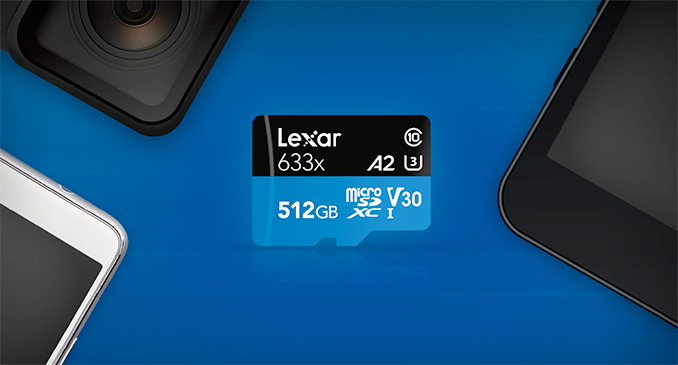Lexar Launches 512 GB microSD Card with A2 App Performance Spec
by Anton Shilov on November 5, 2018 10:00 AM EST- Posted in
- Memory Cards
- Lexar
- SD cards
- A2

Lexar this past week introduced its new family of A2-class microSD cards, the Lexar High-Performance 633x A2. Supporting the highest Application Performance class, the new microSD card is designed in particular for smartphones that need additional storage space for applications. Overall the Lexar High-Performance 633x family of microSD cards is fairly diverse; the cards range in capacity from 16 GB to 512 GB in capacity, and not all of the cards meet an App Performance class standard. Indeed, only the new 512 GB card meets the A2 class standard, while the medium-sized cards are A1 class.
Under the hood, all the cards use the UHS-I bus and are rated for 95 MB/s – 100 MB/s reads as well as 45 MB/s – 70 MB/s writes. Most of the cards in the lineup support the Video Speed Class 30 spec, therefore offering at least 30 MB/s sequential write speeds. As for operating temperature range, it is pretty standard: from 0° to 70° C (32°F to 158°F), which is good enough for everyone except those using specialized devices to work in extreme conditions.
The key feature of the Lexar High-Performance 633x range is of course support for A1 and A2 App Performance specifications, for use with Android phones that need more space for applications. While A1 cards are pretty common these days, A2 cards are still rare partly because they require a more sophisticated (and expensive) controller and partly because not all of their features can be experienced on commonly available hosts.
As we've mentioned before, A2-badged microSD cards mandate a random performance of at least 4000 read IOPS and 2000 write IOPS (vs. 1500/500 read/write IOPS mandated by the A1). Meanwhile, A2-compliant controllers have to support such functions as command queuing (with a minimum depth queue of 2 and a maximum depth queue of 32) to optimize random read performance, caching to hit write performance targets, as well as self-maintenance capabilities. Though to get the most out of an A2 card, the host also needs to support command queuing to guarantee the device's read performance.
| Lexar High-Performance 633x microSD Cards | ||||||||
| 512 GB | 256 GB | 128 GB | 64 GB | 32 GB | 16 GB | |||
| Sequential Read Speed | 100 MB/s | 95 MB/s | ||||||
| Sequential Write Speed | 70 MB/s | 45 MB/s | ? | |||||
| Minimum Sequential Write Speed | 30 MB/s | 10 MB/s | ||||||
| Minimal Random Read Speed | 4000 IOPS | 1500 IOPS | ? | |||||
| Minimal Random Write Speed | 2000 IOPS | 500 IOPS | ? | |||||
| Operating Temperatures | 0° to 70° C (32°F to 158°F) | |||||||
| Interface | UHS-I | |||||||
| Availability | Q4 2018 | |||||||
| SDA Labels | A2, V30, U3 | A1, V30, U3 | A1, V10, U1 | U1 | ||||
| Part Numbers | LSDMI512BBNL633A LSDMI256BBNL633A LSDMI128BBNL633A LSDMI64BBNL633A LSDMI32BBNL633A LSDMI16BBNL633A |
|||||||
Lexar’s High-Performance 633x family of microSD are already available from retailers like Amazon. The models featuring capacities up to 256 GB are priced up to $179.99. The top-of-the-range 512 GB A2-compliant model is expected to hit the market shortly at a price of $299.99.
Related Reading:
- SanDisk Extreme microSD Cards with A2 App Performance Spec Unveiled: 4K/2K IOPS
- Western Digital Launches SanDisk Ultra microSD Card with 400 GB Capacity
- ADATA Demos A2-class microSD Card with 4K/2K IOPS Minimum, Mulls Late 2017 Launch
- SD Association Announces UHS-III (up to 624 MB/s), A2 Class, LV Signaling
- Western Digital Begins to Sample QLC BiCS4: 1.33 Tbit 96-Layer 3D NAND
- Western Digital Demos SD Card with PCIe x1 Interface, 880 MB/s Read Speed
Source: Lexar











17 Comments
View All Comments
PeachNCream - Monday, November 5, 2018 - link
I shouldn't have broken down and purchased SanDisk 400GB cards for my phone and tablet. With more competition, the prices will drop in the 512GB space and since moving off 256GB, I'm already starting to look at the ~110GB left on each of my current cards and cringing a little. I need more space for videos, but then again, the difference between 400GB and 512GB isn't that much. I think I'll have to start getting a lot more selective about what I keep on my phone before we get 1TB microSD and I upgrade again.deil - Monday, November 5, 2018 - link
make home NAS and use 8x 15 TB platters.= ~60 TB of safe space. With enough config you have automated backup, upload and access from all devices.PeachNCream - Monday, November 5, 2018 - link
That's like using a sledgehammer and railroad spikes to hang a cat meme poster on a corkboard.Xajel - Tuesday, November 6, 2018 - link
Dude you have big imagination :DLauRoman - Monday, November 5, 2018 - link
MTBF is 5 days, right? :Dgodrilla - Monday, November 5, 2018 - link
Whats the best tool to test the speeds of micro sd cards heard there is a lot of fakes being sold out there.imaheadcase - Monday, November 5, 2018 - link
I know what you mean, its hard to test also because the test itself could bork the card. Prob just get a micro SD reader and copy it full and remove data to see speeds in windows. But the most annoying part of microsd cards is no one has made a multiple microSD card reader to make testing fast! I'm not sure why this does not exist. I mean sure bandwith would slow between cards if using more thanone, but its more about having access to a lot at a time instad of constantly swapping in and out to see what is what.frodesky - Monday, November 5, 2018 - link
https://techcrunch.com/2010/12/01/multi-card-sd-an... There are also multi-SD readers if you do some googling, and can easily be used with adapters.deil - Monday, November 5, 2018 - link
https://what-if.xkcd.com/31/just reminding you guys as each microsd card is ~0.165 milliliters we have 512gb*22941(cards per galon) = 11.5 petabytes per gallon! with 400 GB cards it was just 9.
alacard - Monday, November 5, 2018 - link
I know i'm a lightweight in this scene but my first computer had 40 MegaBytes of HD space, and sported a full meg of RAM. Upgrading it to two megs set my family back a couple hundred dollars.Today the computer in my bedroom has 64GB of the fastest ram available, which only cost 2.5 times that extra meg of RAM (that was 1992, this was 2016). I have roughly 80TB of both internal and external storage scattered around the house, the whole of which contains exponentially more information than the Great Library of Alexandria did before the Romans burned it to the ground.
The 6700k and GTX 970 which drives the rig in my bedroom are millions if not billions of times more powerful than the processing power that sent our boys to the moon. The titanium Seasonic power supply fueling that rig is probably more efficient than the rocket engines our boys strapped themselves to.
When it comes to politics, the more things change the more they stay the same.
When it comes to technology, the more things change... the more they change exponentially.
And hey guys, let's use technology for the benefit of us all and not as tools of destruction, oppression, subjugation, or control.